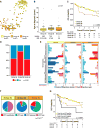Intertumoral Heterogeneity within Medulloblastoma Subgroups
- PMID: 28609654
- PMCID: PMC6163053
- DOI: 10.1016/j.ccell.2017.05.005
Intertumoral Heterogeneity within Medulloblastoma Subgroups
Abstract
While molecular subgrouping has revolutionized medulloblastoma classification, the extent of heterogeneity within subgroups is unknown. Similarity network fusion (SNF) applied to genome-wide DNA methylation and gene expression data across 763 primary samples identifies very homogeneous clusters of patients, supporting the presence of medulloblastoma subtypes. After integration of somatic copy-number alterations, and clinical features specific to each cluster, we identify 12 different subtypes of medulloblastoma. Integrative analysis using SNF further delineates group 3 from group 4 medulloblastoma, which is not as readily apparent through analyses of individual data types. Two clear subtypes of infants with Sonic Hedgehog medulloblastoma with disparate outcomes and biology are identified. Medulloblastoma subtypes identified through integrative clustering have important implications for stratification of future clinical trials.
Keywords: copy number; gene expression; integrative clustering; medulloblastoma; methylation; subgroups.
Copyright © 2017 Elsevier Inc. All rights reserved.
Figures








Comment in
-
From One to Many: Further Refinement of Medulloblastoma Subtypes Offers Promise for Personalized Therapy.Cancer Cell. 2017 Jun 12;31(6):727-729. doi: 10.1016/j.ccell.2017.05.013. Cancer Cell. 2017. PMID: 28609651
References
Publication types
MeSH terms
Grants and funding
LinkOut - more resources
Full Text Sources
Other Literature Sources
Molecular Biology Databases

